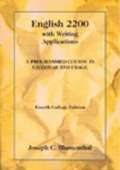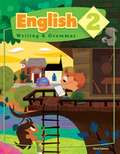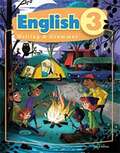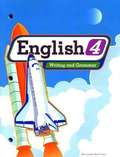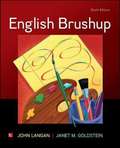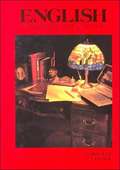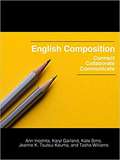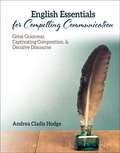- Table View
- List View
English 10th Standard - Tamilnadu Board
by Training State Council of Educational ResearchEnglish Textbook for the 10th Standard Students, preparing for Tamil Nadu State Board Exam.
English 2200 with Writing Applications: A Programmed Course in Grammar and Usage (Fourth College Edition)
by Joseph C. BlumenthalENGLISH 2200, ENGLISH 2600, and ENGLISH 3200 are the original programmed courses in grammar, usage, sentence-building, capitalization, and punctuation.
English 2: Writing & Grammar
by Gina Bradstreet Sandra Bircher Christine ThomasThe English 2: Writing and Grammar (3rd ed.) Student Text is a colorful, inviting, grade appropriate worktext for the second grader. Students focus on understanding the subject and verb parts of sentences, and they will be able to locate the subject and verb of a sentence on completion of the course.
English 3: Writing and Grammar (Student Worktext)
by Bju Press Staff Bob Jones University Staff Tammy D. Jacobs Peggy DavenportEquipped with English materials to emphasize on grammar and writing skills for every child as they write a story, a book report, a research report, a letter, a poem, a research report, instructions, and essays.
English 3: Writing and Grammar Worktext
by Bju PressThe student edition combines grammar and writing practice in one consumable book. Grammar chapters emphasize traditional grammar to support the writing chapters. Paragraph development is simplified with a color-coded paragraph structure showing a topic sentence, detail sentences, and a concluding sentence. In the writing chapters, the step-by-step writing process enables the students to write reports, essays, and other assignments with confidence. <p><p>Additional writing opportunities are available in the grammar lessons. The grammar skills build from lesson to lesson, providing spiral review of previously learned concepts. The worktext provides opportunities for teacher-guided practice, independent practice, chapter reviews, and cumulative reviews. A handbook in the back matter includes a thesaurus, grammar songs, capitalization rules, and abbreviations charts.. - Publisher.English 3 Writing and Grammar Worktext
English 4: Writing and Grammar
by Bju PressEmphasis on traditional grammar as well as practice with vital reference skills and step-by-step use of the Writing Process for eight different types of writing assignments, such as compare-contract essays, persuasive business letters, and more.The student worktext provides guided practice, independent practice, chapter reviews, and cumulative reviews. Located at the back of the worktext, the Writing Handbook contains a thesaurus and writing models, and the Grammar Handbook contains a lists of abbreviations, prepositions, homophones, and diagramming models.
English 5 Student Worktext
by Emily Gray Eileen M. Berry Sarah Clayton Nancy Jean HolmesThis textbook was written by members of the faculty and staff of Bob Jones University. Standing for the "old-time religion" and the absolute authority of the Bible since 1927, Bob Jones University is the world's leading fundamental Christian university.
English 6 Student Text
by Bju PressThe book starts with review of sentence types and then reviews different parts of speech together with different types of writing. A writing chapter follows each grammar chapter that provide a strong link between the grammar chapter and writing chapter. Student learn how to write personal narratives, newspaper editorials, instructions, research papers, historical fiction, compare and contrast essays, free verse, and cover letters.
English Brushup (Sixth Edition)
by Janet M. Goldstein John LanganEnglish Brushup 6e offers a brief and inexpensive guide to the grammar, punctuation, and usage skills that students need most. It offers a combination of features not found in other texts. Its focus is on important skills, self-teaching approach, reasonable size, and outstanding instructor's supplements.
English Class 6 - Nepal
by Curriculum Development Center Nepal Curriculum Development CentreThis accessible book has been published by ADRAD Nepal, with support of Australian Aid. All rights reserved. No part of this publication may be reproduced, stored in a retrieval system or transmitted, in any other form or by any means for commercial purpose without the priorpermission in writing of the Curriculum Development Centre.
English Composition And Grammar, First Course: Grade 7
by John E. WarrinerEnglish composition and grammar: First course
English Composition and Grammar (Fourth Course, Benchmark Edition)
by John E. WarrinerThis textbook is designed to help student improve his ability to use English. It shows how the English sentence works, how words are combined in sentences, and how the parts of sentences may best be arranged for clear communication. The contents of this five Parts book are: Composition: The Writing Process, Composition: Writing and Revising Sentences, Tools for Writing and Revising, Resources for Writing and Studying, and Speaking and Listening.
English Composition and Grammar (Second Course, Liberty Edition)
by John E. WarrinerThis textbook helps students master these three areas -- grammar, composition, and speech.
English Composition and Grammar: Complete Course (Benchmark Edition, Grade #12)
by John E. WarrinerThis textbook is designed to help you master the skills required for the effective use of standard English. Although the book will help you to speak better, its primary purpose is to help you to write better.
English Composition: Connect, Collaborate, Communicate
by Ann Innoshita Karyl Garland Kate Sims Jeanne Tsutsui Keuma Tasha WilliamsThis OER textbook has been designed for students to learn the foundational concepts for English 100 (first-year college composition). The content aligns to learning outcomes across all campuses in the University of Hawai'i system. It was designed, written, and edited during a three day book sprint in May, 2019.
English Essentials
by John Langan Beth JohnsonIn the words of the text's best-selling author, John Langan, "Grammar books can be really dull. But they don't have to be. English Essentials is a new text that makes grammar, punctuation, and usage interesting--with pictures, stories, and activities students will enjoy. " The affordable price, ease of use, and simple, familiar language distinguish this engaging text from others on the market.
English Essentials for Compelling Communication: Great Grammar, Captivating Composition, & Decisive Discourse
by Andrea Cladis HodgeThis book was written for entry-level college freshman needing a comprehensive review of how to both use and understand the English language while gaining sufficient written and oral skills needed to excel in all other college courses. As a foundational learning tool, students can use this book to practice grammar, grow their lexicon, improve their reading levels, and work toward overall mastery of the English language. The content of the instruction in this book employs a scaffolding format so it works best to use this book in the order in which it is written. However, if more focused topical learning is desired, please use the table of contents to direct your selected usage of this book.

